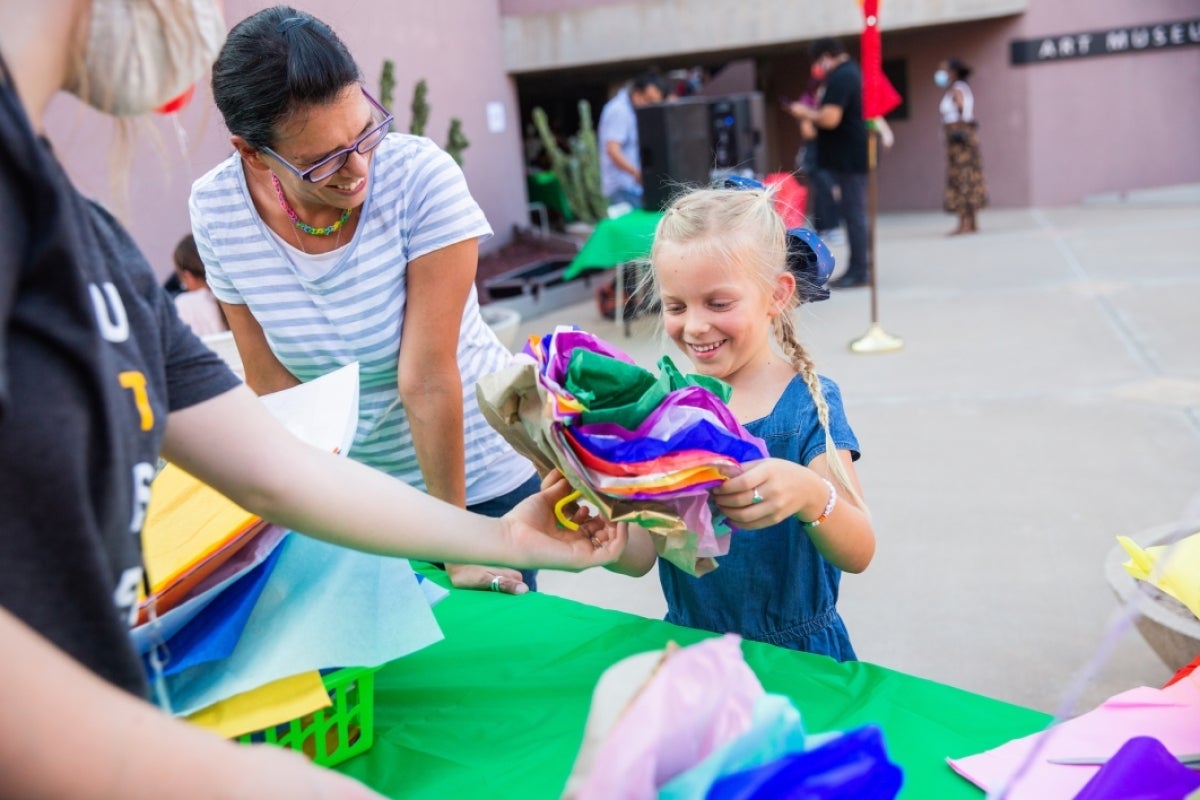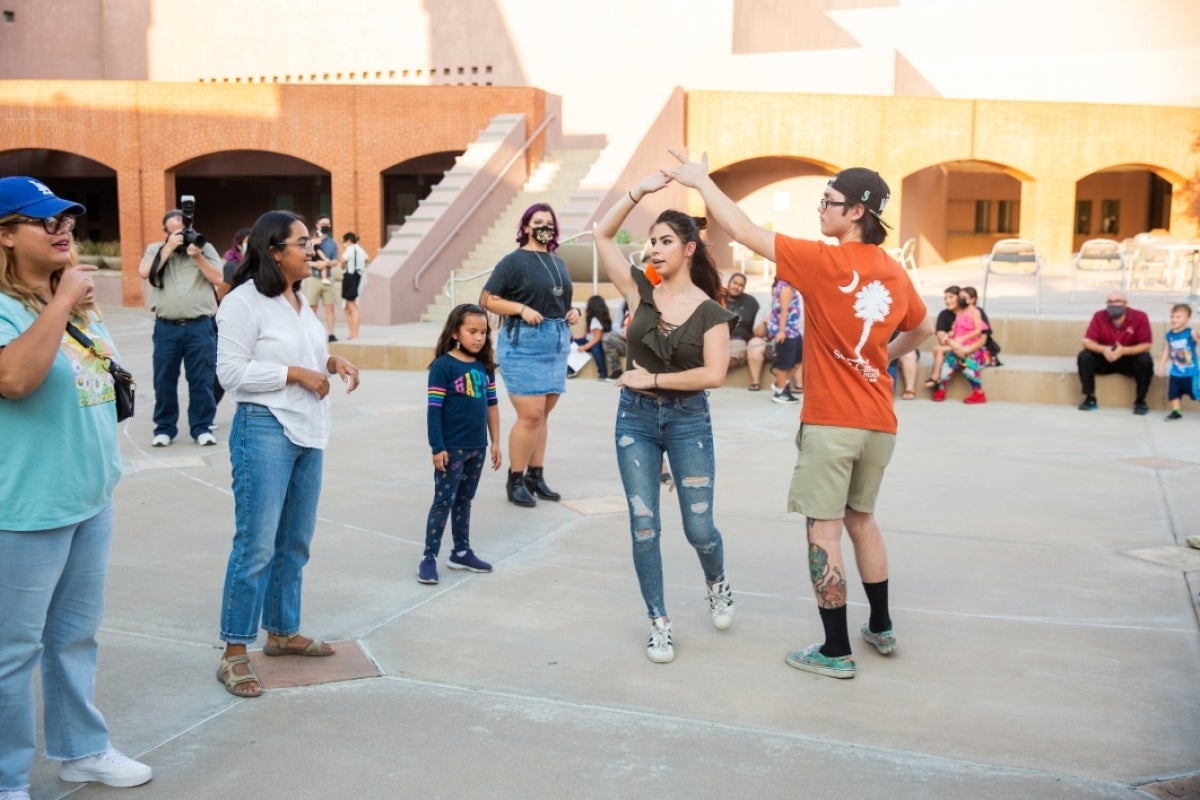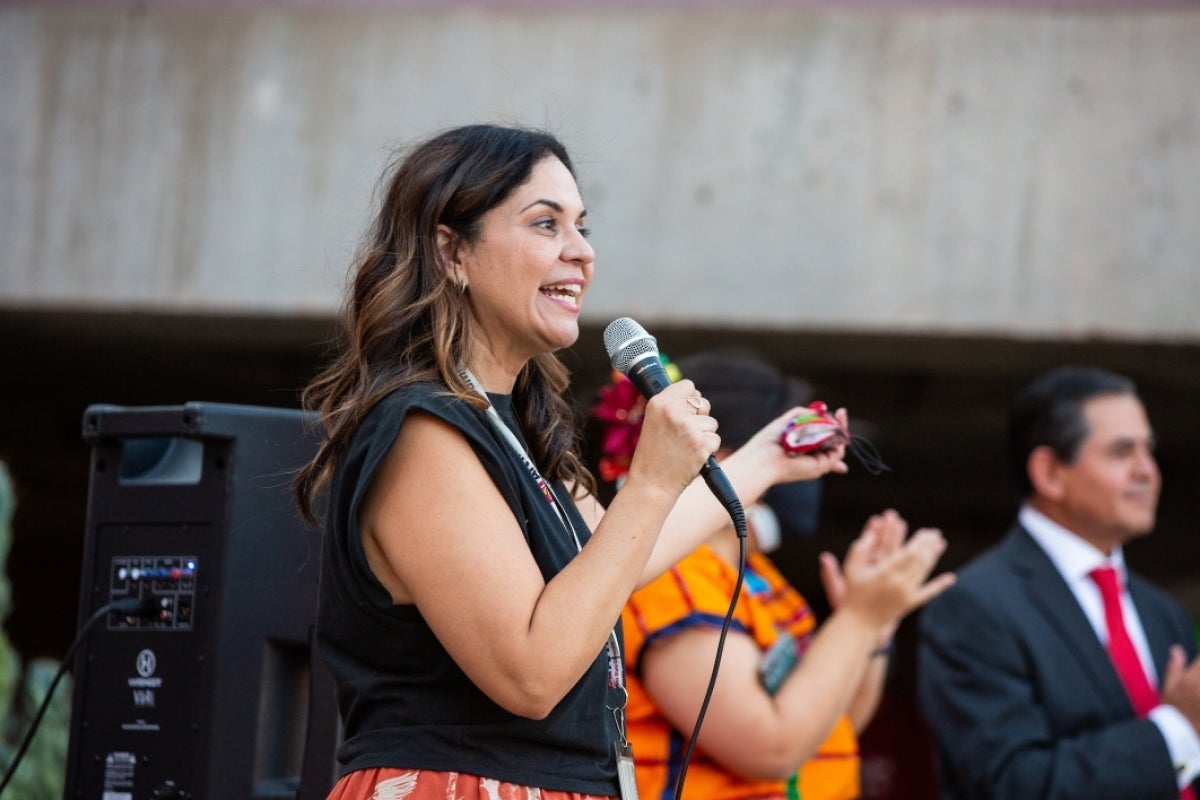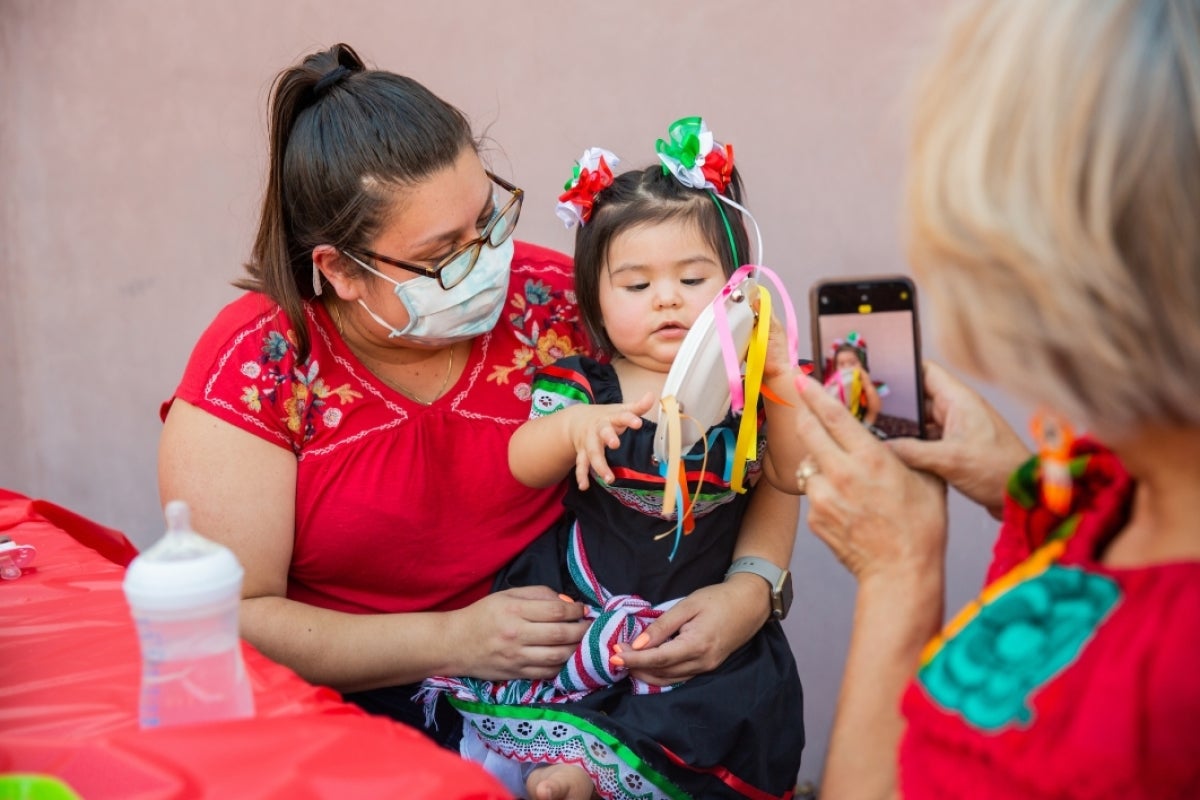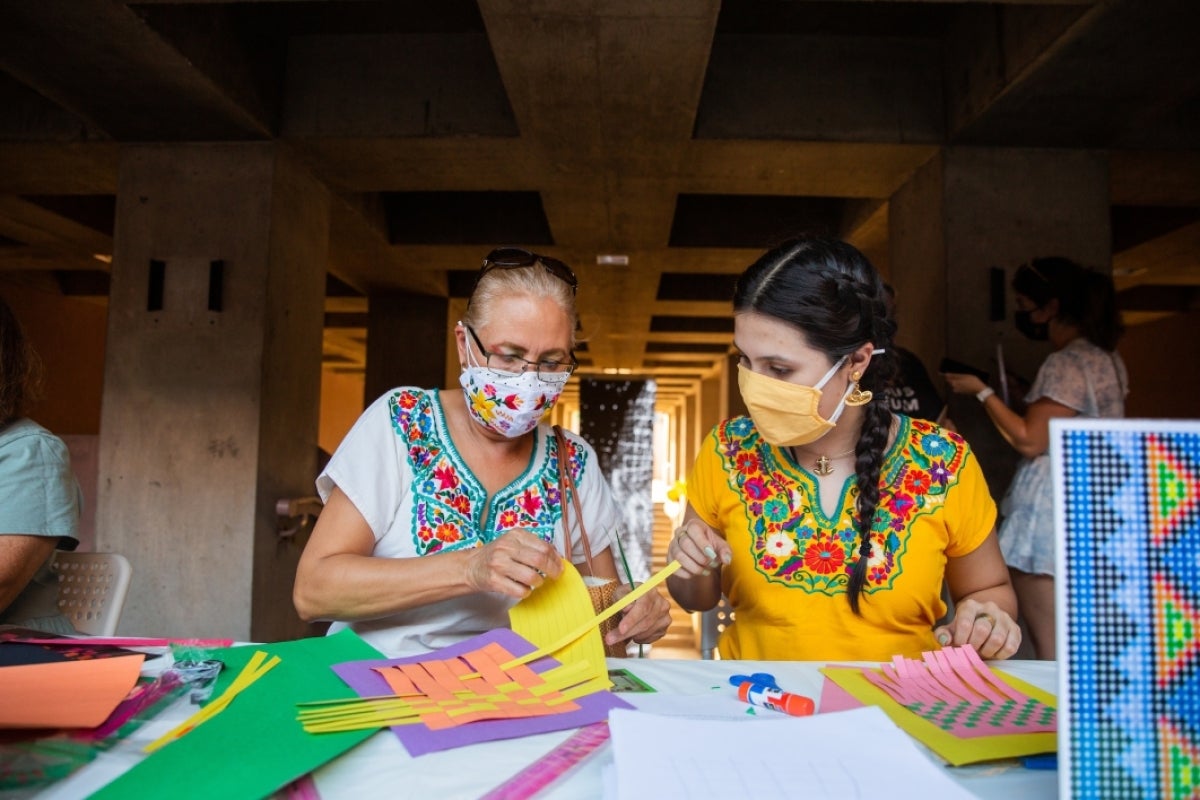The ASU Art Museum celebrated its third annual Mexican Independence Day on Wednesday night by recognizing the culture and contributions of the Mexican and Mexican American communities in Arizona.
The event, held outdoors, included music played by DJ CRVNT3S, bachata and salsa lessons taught by Dance FX, game tables set up with loteria, Salvadorian-Mexican food plated up by ZPotes Food Truck, and various do-it-yourself activities such as making homemade paper piñatas, sombreros, Mexican flags and paper Huichol weavings brought by Phoenix guest artist Gloria Martinez-Granados.
Martinez-Granados explained that she decided to spotlight this variation of the traditional Huichol looms because it gives her a sense of identity as a Mexican American woman and artist. Her hope was to help bring awareness to this Indigenous culture and have the community members attending the event actively experience the culture behind Huichol, a group that mainly lives in the Sierra Madre Occidental in western Mexico.

Phoenix guest artist Gloria Martinez-Granados spotlighted Indigenous Huichol weavings at the event Wednesday. “I want them to connect with the culture. Beyond just the Huichol culture, weaving is a practice that is ancient,” she said.
“I want them to connect with the culture. Beyond just the Huichol culture, weaving is a practice that is ancient,” said Martinez-Granados, who was brought to the event through the CALA Alliance (Celebración Artística de las Américas). “I think it’s really important to celebrate cultures because we live in such a diverse nation and it’s important to have a sense of belonging. Having events like this helps build community and allows people to come and experience culture actively.”
Last year, the Mexican Independence Day event was held online. Andrea Feller, the curator of education at the ASU Art Museum, expressed how happy the museum is to be able to continue its tradition of hosting the celebration in-person while following ASU’s guidelines of having a socially distanced program during the COVID-19 pandemic.
“Our Mexican Independence Day event allows us to celebrate our long commitment of exhibiting art by Hispanic artists and connect with our local and campus community,” Feller said. “It’s an honor to kick off Hispanic Heritage month with our program.”
ASU students and surrounding community members from the Tempe and Phoenix areas enjoyed the various activities, music and the annual Grito, which was performed this year by Deputy Consul Armando Manuel Esparza Miranda from the Consulate General of Mexico in Phoenix.
El Grito, or “the yell” (also called el Grito de Dolores), is a centuries-old tradition that began Sept. 15, 1810, just before midnight when Miguel Hidalgo y Costilla, a Roman Catholic priest from the small town of Dolores, Mexico, cried out against colonial rule. He rang the church bells in the town and cried out for the native Mexican people to take back their land from their Spanish oppressors, ending his speech with the infamous cry: “Viva Mexico!” or “Long live Mexico!” His actions eventually rallied thousands of people to fight for Mexican independence.
Each year it is performed as a call-and-response the evening before Mexican Independence Day (which is Sept. 16). One person calls out the names of Mexican leaders and the crowd replies “Viva!” each time.
“The Grito is the start of our history as an independent country, but it’s also a gathering when we make community and we celebrate our roots,” said Maria del Rocio Rodriguez Echeverria, the consul for cultural and community efforts in the Consulate General of Mexico. “It’s a big source of pride to see families coming together and celebrate our independence.”
Children and adults alike stood in the courtyard of the ASU Art Museum on Wednesday yelling “Viva!” in reply to the deputy’s Grito.
“This is an important day to be proud of the culture and history of the Southwest United States, and part of that culture and history comes from Mexico,” said Miki Garcia, the director of the ASU Art Museum.
ASU psychology students Andres Cervantes and Paloma Amaya joined the festivities by participating in the Grito and art activities. As Phoenix natives of Mexican descent, Cervantes and Amaya expressed their gratitude for the ASU event as it brings awareness of Mexican culture in a respectful way.
“It’s really cool that we get this representation at ASU even with its diverse population so we feel like we’re a part of it,” Cervantes said.
In addition to the celebration and festivities, the ASU Art Museum recently opened the new “Undoing Time: Art and Histories of Incarceration” exhibition, which features artwork from a diverse selection of Latino artists, among others. The museum consistently features work from artists of Latin descent throughout each year and strives to make sure its exhibits celebrate different cultures.
“Every month is Hispanic Heritage Month at ASU Art Museum,” said Julio Cesar Morales, the senior curator of the ASU Art Museum. “It’s arte para todos, art for everyone.”
To continue celebrating Hispanic Heritage Month, find more ASU events scheduled throughout September until Oct. 15.
Top photo: Geography graduate student Norma Lopez-Castaneda spins as everyone learns how to bachata during the Mexican Independence Day celebration hosted by the ASU Art Museum on the Tempe campus Sept. 15. Photo by Deanna Dent/ASU News
More Arts, humanities and education

ASU professor's project helps students learn complex topics
One of Arizona State University’s top professors is using her signature research project to improve how college students learn science, technology, engineering, math and medicine.Micki Chi, who is a…

Award-winning playwright shares her scriptwriting process with ASU students
Actions speak louder than words. That’s why award-winning playwright Y York is workshopping her latest play, "Becoming Awesome," with actors at Arizona State University this week. “I want…

Exceeding great expectations in downtown Mesa
Anyone visiting downtown Mesa over the past couple of years has a lot to rave about: The bevy of restaurants, unique local shops, entertainment venues and inviting spaces that beg for attention from…



